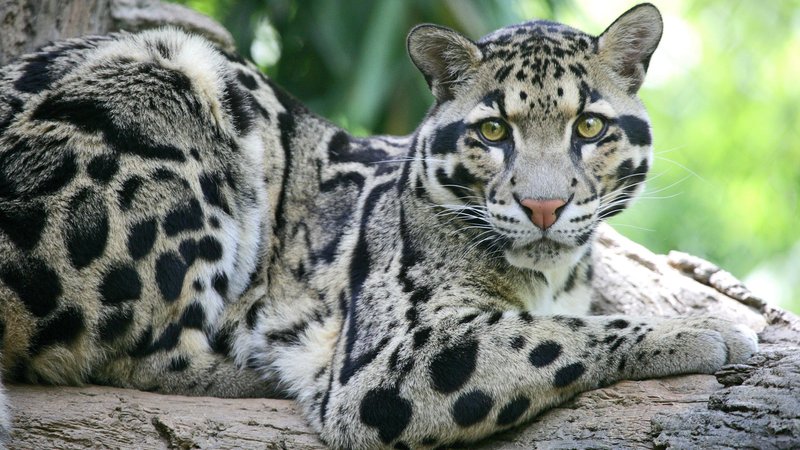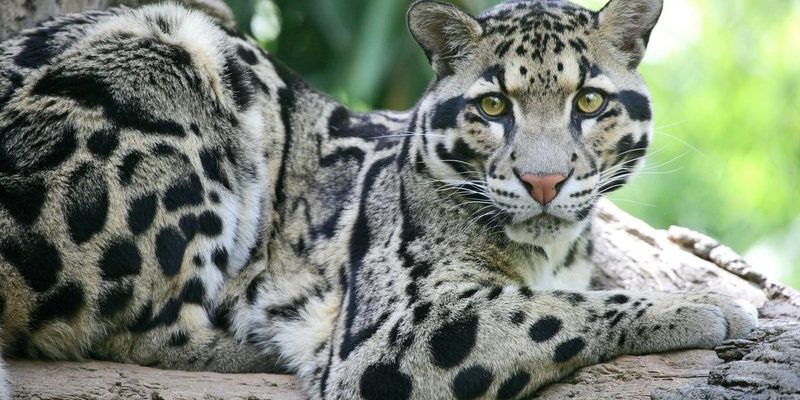
Clouded leopards may not be as famous as their cousins, the Bengal or African leopards, but they have a personality all their own. With their beautiful, cloud-like markings and almost mystical presence in the dense forests of their habitat, these leopards deserve some time in the spotlight. So, grab a cup of coffee and settle in! Let’s explore ten captivating facts about the clouded leopard that will leave you wanting to learn even more.
1. Unique Physical Features
The clouded leopard is known for its striking appearance. With stunning coat patterns that resemble soft, fluffy clouds, this cat is truly a sight to behold. The background of their fur ranges from a darker yellow to a greyish hue, adorned with large, irregular dark spots. These *cloud-like* patterns provide excellent camouflage in the dappled sunlight of their forest homes, helping them blend seamlessly into their surroundings.
What’s even more interesting is their body structure. Clouded leopards have long, flexible bodies and short legs which enable them to climb trees with remarkable agility. Their long tails—almost as long as their bodies—help them balance as they navigate the forest canopy. It’s like nature designed them perfectly for life in the trees!
2. Masterful Climbing Skills
Speaking of trees, clouded leopards are some of the best climbers among big cats. They can easily scale vertical trunks and leap between branches with grace and ease. You might be wondering why climbing is such an important skill for them. Well, their climbing abilities help them escape predators, stalk prey, and find safe resting spots high above the ground.
Their retractable claws and flexible ankle joints are key to their climbing prowess. Unlike many other big cats, clouded leopards can rotate their ankles, allowing them to climb down trees headfirst! Imagine being able to shimmy up a tree and then come back down looking just as cool. That’s just part of the clouded leopard’s charm.
3. Habitat and Range
Clouded leopards primarily inhabit the forests of Southeast Asia, including regions in countries like Thailand, Malaysia, and Nepal. They thrive in both tropical and subtropical forests, where dense vegetation offers them the cover they need to hunt and roam. These cats prefer areas where there’s a mix of open space and thick underbrush, as it provides plenty of hiding spots for both them and their prey.
However, it’s important to note that their habitat is under threat due to deforestation and human encroachment. With their homes disappearing, clouded leopards face challenges that make their survival increasingly difficult. Protecting their natural habitats is crucial for their continued existence.
4. Diet and Hunting Techniques
Clouded leopards are carnivorous and have a diverse diet. They primarily hunt animals like deer, monkeys, and birds. When they’re on the prowl, they rely on their incredible stealth to sneak up on prey. They’re not just powerful; they’re smart hunters, often using the trees to launch surprise attacks from above.
Interestingly, clouded leopards have a unique way of hunting that sets them apart. They can leap up to 10 feet in a single bound, allowing them to ambush their prey with breathtaking accuracy. With agility that rivals that of a circus acrobat, these cats know how to make the most of their arboreal surroundings.
5. Solitary Lifestyle
Like many big cats, clouded leopards are solitary by nature. They prefer to live alone, marking their territory with scent markings and scratch marks on trees. This lifestyle helps them minimize competition for food and space. When it comes to mating, males and females will come together briefly, but they usually go their separate ways after that.
During the mating season, males can be quite vocal, using various sounds to communicate with potential mates. These vocalizations include growls, roars, and even chuffing sounds. It’s their way of saying, “Hey, I’m here, and I’m looking for a partner!”
6. Unique Vocalizations
Speaking of sounds, clouded leopards have a fascinating range of vocalizations that are quite different from other big cats. They can produce a variety of calls, including yowls, growls, and chirps. You might think of them as vocal artists in the wild! Their voice is a blend of cat-like growls and more exotic, bird-like calls, making them quite the unique talkers.
These sounds play a crucial role in communication, helping them establish territory and communicate with potential mates. Imagine wandering through the forest and hearing a faint, haunting call echoing through the trees—it’s a reminder that these beautiful creatures are close by.
7. Breeding and Offspring
When it comes to reproduction, clouded leopards have a relatively straightforward breeding cycle. After a gestation period of about 93 to 95 days, the female gives birth to a litter of one to five cubs. The cubs are born blind and depend on their mother for survival during their first few weeks of life.
As they grow, these little leopards start to explore their surroundings, fueled by their natural curiosity. They learn valuable skills from their mother, such as hunting techniques and climbing. Cubs usually stay with their mother for about a year before becoming independent, venturing off to carve their own territory in the wild.
8. Conservation Status
Sadly, clouded leopards are classified as vulnerable by the International Union for Conservation of Nature (IUCN). Their population is declining due to habitat loss, illegal logging, and poaching. As their homes are destroyed and prey becomes scarce, these beautiful cats face an uncertain future.
Conservation efforts are underway to protect clouded leopards and their habitats. Organizations are working tirelessly to raise awareness, mitigate hunting pressures, and establish protected areas. Every little bit helps, and supporting such initiatives can make a significant difference.
9. Cultural Significance
In various cultures across Southeast Asia, clouded leopards hold significant symbolism. They are often seen as symbols of strength and mystery. In some traditions, they are celebrated in folklore and stories, adding to the mystique surrounding these incredible animals. Their striking appearance and elusive nature have made them a part of local narratives, where they’re often depicted as powerful guardians of the forest.
This cultural reverence can also aid in conservation efforts. When communities value and respect these animals, it can lead to greater protection and appreciation for their natural habitat.
10. Clouded Leopard vs. Other Big Cats
You might be curious about how clouded leopards compare to other big cats. They’re not as large as lions or tigers, but their size and agility make them unique in the feline family. They’re more closely related to the snow leopard than to other leopards found in Africa. In fact, their genetic makeup shows distinct differences that set them apart.
Comparing their behavior also reveals many differences. While other big cats may be more social (like lions), clouded leopards tend to thrive in solitude. Their tree-dwelling lifestyle and specialized hunting methods further make them an intriguing species within the diverse world of felines.
In conclusion, the clouded leopard may not be the most well-known big cat, but it certainly is one of the most fascinating. From its unique climbing abilities to its important role in the ecosystem, there’s so much to appreciate about this extraordinary creature. By learning more and advocating for their protection, we can help ensure that clouded leopards continue to thrive for generations to come. Let’s keep the conversation going and share the beauty of these elusive cats with others!

